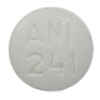Methazolamide
This is a prescription item
We’ll collect your veterinarian’s information at checkout to authorize the prescription.

Don’t have a veterinarian? Book an appointment with Vetster
 Temporarily Out of Stock
Temporarily Out of Stock
 Thank you, we will notify you when this product is available.
Thank you, we will notify you when this product is available.
What is Methazolamide?
Methazolamide is used to treat ocular conditions where lowering intraocular pressure is likely to be of therapeutic benefit, such as chronic open-angle glaucoma, secondary glaucoma, and pre-operatively in acute angle-closure glaucoma where lowering the intraocular pressure is desired before surgery. Methazolamide is sold per tablet requires a prescription from your veterinarian.
For:
Dogs
Benefits:
- Lowers intraocular pressure
- Easy to administer
- Sold per tablet
How does methazolamide work?
Methazolamide inhibits the actions of carbonic anhydrase, thereby reducing the amount of fluid produced in the eyes and therefore reducing pressure.
Cautions:
The side effects of methazolamide may include GI disturbances, drowsiness, depression or excitement, changes in urination, diabetes, rash, hypersensitivity, or an increased sensitivity of the skin to sunlight. Tell your veterinarian about any other medications you are giving your pet, and contact your veterinarian immediately if your pet experiences any of the above side effects.
Brand Name:
Neptazane (Storz)
Generic Name:
Methazolamide (meth-a-zole'-a-myde)
What is the most important thing I should know about methazolamide?
Methazolamide is a carbonic anhydrase inhibitor used to treat glaucoma by reducing the amount of fluid produced in the eyes. Methazolamide may also be used for purposes other than those listed here. Methazolamide is a prescription medication that is not FDA approved for use in veterinary medicine; however, it is a commonly accepted practice for veterinarians to use this medication in dogs. Methazolamide is available as 25 mg and 50 mg tablets. The usual dose for dogs is 1 mg/lb 2 or 3 times a day. Contact your veterinarian immediately if your pet develops fever, unusual bleeding, tremors in the legs, pain or a rash. These symptoms could be early signs of a serious side effect. Methazolamide may cause dizziness or drowsiness. Methazolamide may increase sensitivity of the skin to sunlight.
What should I discuss with my veterinarian before giving methazolamide to my pet?
Tell your veterinarian if your pet has ever had an allergic reaction to a sulfa based drug such as sulfadimethoxine (Albon) or sulfamethoxazole (SMZ-TMP, Bactrim, Septra). Tell your veterinarian if your pet is taking aspirin, or if your pet has liver, kidney, heart or lung disease or hormonal disease. Tell your veterinarian if your pet is pregnant or lactating.
How should methazolamide be given?
Give Methazolamide exactly as directed by your veterinarian. If you do not understand the directions ask your pharmacist or veterinarian to explain them to you. Give methazolamide with food and have water readily available to the pet. Store methazolamide at room temperature away from moisture and heat. Keep this medication away from children and pets.
What are the potential side effects of methazolamide?
Stop giving methazolamide and contact your veterinarian immediately if your pet has an allergic reaction (difficulty breathing; swelling of the lips, tongue, face; and/or hives), fever, unusual bleeding or bruising, pain, tingling or tremors in the legs, or a rash. Other less serious side effects that may occur include decreased appetite, nausea, vomiting, constipation, diarrhea, dizziness, drowsiness, confusion, increased sensitivity of the skin to sunlight, difficulty controlling blood sugar, hearing or vision problems. Continue to give the medication and contact your veterinarian.
What happens if I miss giving a dose of methazolamide?
Give the missed dose as soon as you remember during the same day. However, if you don't remember until the next day, skip the dose you missed and give only the next regularly scheduled dose. Do not give a double dose of the medication.
What happens if I overdose my pet on methazolamide?
If you suspect that your pet has received an overdose of methazolamide, consult your veterinarian or emergency veterinary clinic immediately.
What should I avoid while giving methazolamide to my pet?
Methazolamide may cause drowsiness. Avoid prolonged exposure of your pet to sunlight.
What other drugs will affect methazolamide?
Before giving methazolamide, tell your veterinarian if your pet is being given cyclosporine, primidone, aspirin, choline salicylate or other salicylates. Also tell your veterinarian of any other medications you are giving that may cause drowsiness such as pain relievers, anxiety medications, muscle relaxants or any other prescription or over the counter medications.
Methazolamide Directions:
- Methazolamide, a carbonic anhydrase inhibitor, is a prescription medication used in dogs to treat intra-ocular pressure (glaucoma) by reducing the amount of fluid in the eyes.
- Methazolamide is not FDA approved for use in veterinary medicine; however, it is a commonly accepted practice for veterinarians to prescribe this medication for dogs.
- Methazolamide may increase sensitivity of the skin to sunlight.
- Tell your veterinarian about any other medications you are giving your pet.
Contact your veterinarian immediately if your pet develops fever, unusual bleeding, tremors in the legs, pain, or a rash.
Methazolamide Dosage:
| Weight | Dosage |
|---|---|
| All weights | The usual dose is 1 mg/lb of the pet's body weight 2 or 3 times a day |
| Cats | Do not use! |
|---|
| Horses | Do not use! |
|---|
Storage:
Should at 68°-77°F (20°-25°C) and protect from light, moisture, and heat.
Methazolamide Ingredients:
| Active Ingredients (per tablet) | Amount |
|---|---|
| Methazolamide | 25 mg |
| Other Ingredients:Dibasic calcium phosphate dihydrate, glyceryl behenate, povidone, pregelatinized starch, and sodium starch glycolate. | |
| Active Ingredients (per tablet) | Amount |
|---|---|
| Methazolamide | 50 mg |
| Other Ingredients:Dibasic calcium phosphate dihydrate, glyceryl behenate, povidone, pregelatinized starch, and sodium starch glycolate. | |
 Swipe
Swipe
 AutoShip
AutoShip
Use code SAVE35
 AutoShip
AutoShip
Use code SAVE35
Customers also boughtView All
 Swipe
Swipe
















































